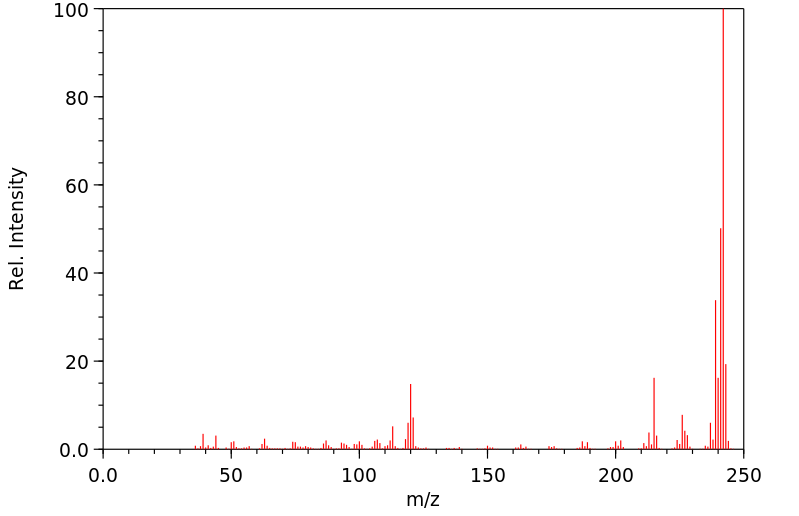1-甲基苯并菲 | 2871-91-2
中文名称
1-甲基苯并菲
中文别名
——
英文名称
1-methyltriphenylene
英文别名
2-methyltriphenylene;1-methyl-triphenylene;1-Methyl-triphenylen;1-Methyltriphenylen
CAS
2871-91-2
化学式
C19H14
mdl
——
分子量
242.32
InChiKey
DUFXBFANDZVWSR-UHFFFAOYSA-N
BEILSTEIN
——
EINECS
——
-
物化性质
-
计算性质
-
ADMET
-
安全信息
-
SDS
-
制备方法与用途
-
上下游信息
-
文献信息
-
表征谱图
-
同类化合物
-
相关功能分类
-
相关结构分类
物化性质
-
保留指数:415.45;416.32;416.32;416.32
计算性质
-
辛醇/水分配系数(LogP):5.2
-
重原子数:19
-
可旋转键数:0
-
环数:4.0
-
sp3杂化的碳原子比例:0.05
-
拓扑面积:0
-
氢给体数:0
-
氢受体数:0
安全信息
-
海关编码:2902909090
SDS
反应信息
-
作为反应物:描述:1-甲基苯并菲 在 N-溴代丁二酰亚胺(NBS) 、 过氧化氢苯甲酰 、 potassium carbonate 作用下, 以 四氯化碳 、 乙醇 为溶剂, 反应 2.5h, 生成 2-[(1-Triphenylenylmethyl)amino]-2-methyl-1,3-propanediol参考文献:名称:2-[(Arylmethyl)amino]-2-methyl-1,3-propanediol DNA intercalators. An examination of the effects of aromatic ring variation on antitumor activity and DNA binding摘要:The effects of variation of aromatic ring size, shape, and side-chain position on antitumor activity and DNA binding in a series of carbocyclic 2-[(arylmethyl)amino]-2-methyl-1,3-propanediols (AMAPs) were examined. In general, the interaction of AMAPs with DNA increases as the intercalating ring system grows in area, with three distinct binding levels evident. Isomers from a specific ring system appear to bind DNA similarly. DNA binding is not the sole criterion for antitumor activity for the AMAPs studied; the magnitude of the DELTA-T(m) does not correlate with the antitumor activity observed. Significant in vivo P388 activity was seen for AMAP congeners from several tetracyclic ring systems. However, isomers from each of the specific ring systems produced a wide range of in vivo P388 activity. Thus, AMAP antitumor activity is not a function of the ring system per se, but rather appears to be related to the shape of the specific molecule. Three AMAP congeners (crisnatol (770U82, 773U82, and 502U83) are currently in clinical trials.DOI:10.1021/jm00111a010
-
作为产物:描述:3,4,9,10,11,12-hexahydro-2H-triphenylen-1-one 在 palladium on activated charcoal 、 乙醚 、 苯 作用下, 生成 1-甲基苯并菲参考文献:名称:REACTIONS OF TETRAHYDROPHENANTHRENE. THE SYNTHESIS OF TRIPHENYLENE AND METHYLTRIPHENYLENE*摘要:DOI:10.1021/jo01216a014
文献信息
-
Two-in-One Strategy for the Pd(II)-Catalyzed Tandem C–H Arylation/Decarboxylative Annulation Involved with Cyclic Diaryliodonium Salts作者:Tao Hu、Kai Xu、Zenghui Ye、Kai Zhu、Yanqi Wu、Fengzhi ZhangDOI:10.1021/acs.orglett.9b02429日期:2019.9.20We report here a two-in-one strategy for the Pd(II)-catalyzed tandem C–H arylation/decarboxylative annulation between readily available cyclic diaryliodonium salts and benzoic acids. The carboxylic acid functionality can be used as both a directing group for the ortho-C–H arylation and the reactive group for the tandem decarboxylative annulation. By a step-economical double cross-coupling annulation
-
一种9,10-苯并菲类化合物的合成方法申请人:百合花集团股份有限公司公开号:CN107266411B公开(公告)日:2019-06-28
-
C–C Bond (Hetero)arylation of Ring-Fused Benzocyclobutenols and Application in the Assembly of Polycyclic Aromatic Hydrocarbons作者:Wenbin Mao、Chen ZhuDOI:10.1021/acs.joc.7b01727日期:2017.9.1efficient synthetic approach to triphenylene-based polycyclic aromatic hydrocarbons (PAHs) from ring-fused benzocyclobutenols (RBCBs) through the cleavage of the C–C σ-bond. Two key transformations are involved: (a) palladium-catalyzed C–C bond (hetero)arylation of RBCBs; and (b) Lewis acid-promoted intramolecular annulation leading to complex polycyclic compounds. A variety of multiply substituted triphenylenes
-
Palladium Catalyzed C–I and Vicinal C–H Dual Activation of Diaryliodonium Salts for Diarylations: Synthesis of Triphenylenes作者:Xunshen Wu、Jianwei Han、Limin WangDOI:10.1021/acs.joc.7b01905日期:2018.1.5we report an approach for direct diarylations of 2-bromobiphenyls or bromobenzenes. As a result, a wide range of triphenylenes with various substituents have been synthesized in good yields. These triphenylenes are expected to be employed in the “bottom-up” synthesis of functional aromatic molecules in material science.
-
Palladium-Assisted “Aromatic Metamorphosis” of Dibenzothiophenes into Triphenylenes作者:Dhananjayan Vasu、Hideki Yorimitsu、Atsuhiro OsukaDOI:10.1002/anie.201501992日期:2015.6.8Two new palladium‐catalyzed reactions of aromatic sulfur compounds enabled the conversion of dibenzothiophenes into triphenylenes in four steps. This transformation of one aromatic framework into another consists of 1) 4‐chlorobutylation of the dibenzothiophene to form the corresponding sulfonium salt, 2) palladium‐catalyzed arylative ring opening of the sulfonium salt with a sodium tetraarylborate
表征谱图
-
氢谱1HNMR
-
质谱MS
-
碳谱13CNMR
-
红外IR
-
拉曼Raman
-
峰位数据
-
峰位匹配
-
表征信息
同类化合物
(R)-2,2'',3,3''-四氢-6,6''-二-9-菲基-1,1''-螺双[1H-茚]-7,7''-二醇
(6,6)-苯基-C61己酸甲酯
高雌二醇
马兜铃酸钠
马兜铃酸盐
马兜铃酸C
马兜铃酸B
马兜铃酸(1:1MIXTUREOFARISTOLOCHICACIDIANDARISTOLOCHICACIDII)
马兜铃酸 Ia
马兜铃酸 IVa
马兜铃酸
颜料黑32
颜料红179
颜料红178
颜料红149
颜料红123
顺式-菲-1,2-二醇-3,4-环氧化物
顺式-苯并(a)屈-11,12-二醇-13,14-环氧化物
雷公藤酚A
镁二(1,4,5,6,7,16,17,18,19,19,20,20-十二氯六环[14.2.1.14,7.02,15.03,8.09,14]二十-5,9,11,13,17-五烯-11-磺酸酯)
钩大青酮
钩大青酮
钙(2+)12-羟基十八烷酸酯
酒石酸布托诺啡
那布扶林
还原红32
足球烯
贝那他汀B
贝母兰素
萘并[2,3-b]荧蒽
萘并[2,1-e][1]苯并二硫杂环戊烷
萘并[2,1-C:7,8-C']二菲
萘并[1,2-e][2]苯并呋喃-1,3-二酮
萘并[1,2-b]屈
萘并[1,2-a]蒽
萘并[1,2-B]菲-6-醇
萘二(六氯环戊二烯)加合物
萘,8-溴-1,2,3-三(1,1-二甲基乙基)-6-甲基-
菲醌单缩氨基硫脲
菲醌
菲并[9,10]呋喃
菲并[9,10-e]醋菲烯
菲并[4,5-bcd]噻吩
菲并[4,5-bcd]呋喃-3-醇
菲并[4,3-d]-1,3-二噁唑-5-羧酸,10-羟基-9-甲氧基-6-硝基-
菲并[3,2-b]噻吩
菲并[2,1-d]噻唑
菲并[2'',1'',10'':4,5,6;7'',8'',9'':4',5',6']二异喹啉并[2,1-a:2',1'-a']二萘嵌间二氮杂苯-8,13-二酮
菲并(3,4-b)噻吩
菲并(1,2-b)噻吩







